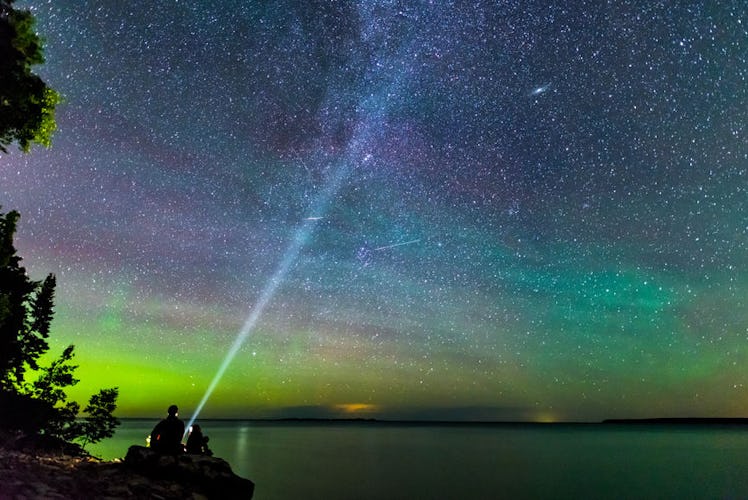
How To Catch The Geminid Meteor Shower In The Midst Of The Holiday Season
Take a moment to look back on the past year and ask yourself whether or not you truly embraced the beauty of the universe. Did you find enough time to take strolls through the countryside? Were you able to swim through a natural body of water? Did you ever stop to gaze upon the stars? If you answered "no" to any of these questions, it's still not too late. You have the opportunity to get a years' worth of cosmic brilliance in one sitting, so take notes on how to see the Geminid meteor shower 2018.
In case you haven't heard, the Geminid meteor shower is one of the most exciting and enchanting meteor showers that we have the privilege of experiencing. According to TimeAndDate.com, as many as 120 meteors per hour can blaze through the sky during its peak, so even if you don't normally care about shooting stars, this is a big deal. And, as you astrology nerds may have already guessed, these meteors travel from the direction of the constellation Gemini. As the shooting stars spiral through the night, feel free to imagine the twins dancing in-between them.
Anyway, enough chatter: Read on to get the most out of this year's Geminid meteor shower experience.
When The Geminid Meteor Shower 2018 Begins
Lucky for you, there's still plenty of time to plan ahead for the upcoming Geminid meteor shower. As reported by TimeAndDate.com, the Geminid peaks from Thursday, Dec. 13 to Friday, Dec. 14. However, if you can't make the peak, the Geminid meteor shower technically begins on Dec. 4 and lasts until around Dec. 17. While the peak is the best time to catch as many shooting stars as you can, you've still got almost two whole weeks to see them.
What Time The Geminid Meteor Shower 2018 Starts
While you can technically glimpse the Geminid meteor shower as soon as it reaches night, there are better times to see it than others. According to Space.com, the meteors will really begin to peak around 2 a.m., but they'll begin to gain traction around 9 or 10 p.m., so it's wise to prepare for a late night of shooting star viewing.
If you're not in the mood to indulge in some caffeine or you're unable sleep-in the next morning, you can still see them earlier in the night. You'll just have to be more patient with the stars.
Where To See The Geminid Meteor Shower 2018
Fortunately, there's not one place you need to be in order to see the Geminid meteor shower in action. However, you'll want to steer clear of big cities and light pollution. To make sure that you can spot even the faintest shooting stars, you should travel somewhere far away from civilization; somewhere rural. By doing so, there will be nothing to impede your view of the cosmic fireworks.
How To See The Geminid Meteor Shower 2018
When planning an evening of meteor shower viewing, it's wise to choose a night in which the sky will be clear and the moonlight will be faint. You may want to check your local weather report in advance. However, we're lucky that the moon will be a mere waxing crescent when the Geminid meteor shower reaches its peak, allowing us to see the sky more vividly.
As always, EarthSky.org recommends that you allow at least 20 minutes for your eyes to adjust to the dark before watching any meteor shower. TimeAndDate.com also implores you to ditch the telescopes and binoculars, for they'll actually get in your way of seeing the meteor shower rather than help you. Simply sit back, relax, and allow the magic to happen to you.